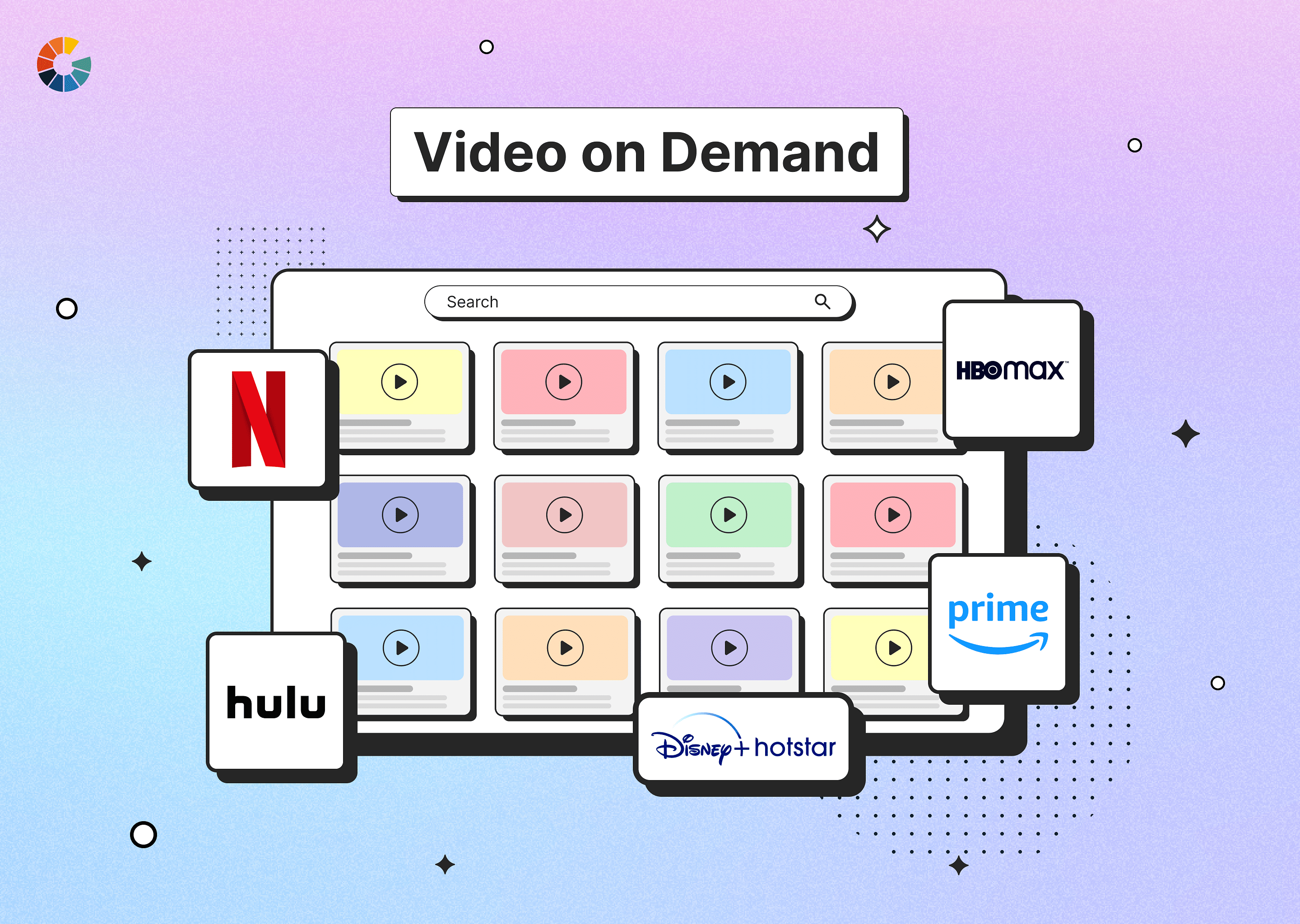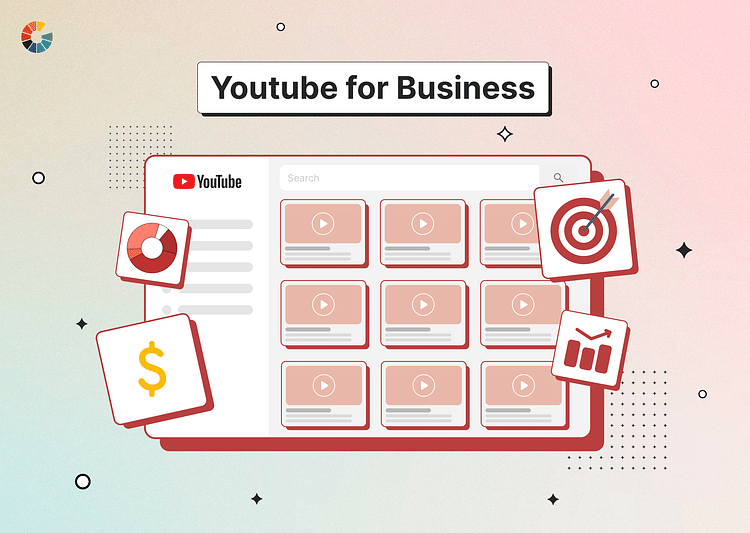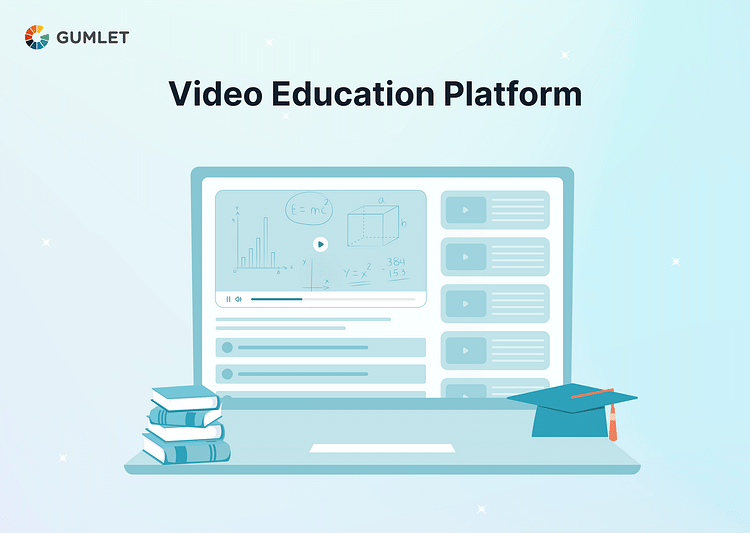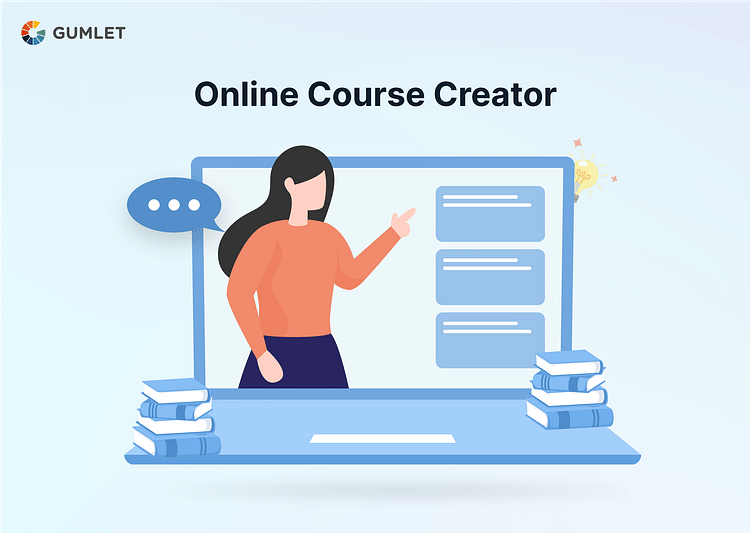What is VOD?
VOD—or video-on-demand—is a content distribution system that allows quick, on-the-go access to content libraries through rentals, purchases, or in exchange for a monthly subscription fee.
VOD moves beyond the traditional broadcasting constraints and allows users to view thousands of movies, TV shows, and podcasts whenever they want, using their choice of platform or device. The modern consumer thrives on this flexibility. VOD has boomed in popularity, with the global VOD market reaching an estimated $890.4 billion in 2023 according to a Statista report.
Important Features Needed for VOD
Here are the top 5 features to look out for when choosing a VOD streaming platform:
Video Hosting
A VOD platform should have a robust, cloud-based Infrastructure for video hosting, which will improve the security of your network and increase the deployment and maintenance potential of the streaming platform.
Encoding and Transcoding
Depending on the device or platform a video is viewed on, the size and quality of the media file need to be changed for high-quality video streaming. For instance, a video designed for PC won't always work well on a mobile phone or if your end-users have unfavorable network conditions, their streaming experience will be interrupted by buffering and lags.
VOD encoding and transcoding help you overcome these obstacles; with the right encoder and transcoder settings, you can deliver content to a variety of devices by optimizing it based on the available bitrates and the device's capacities.
Multiple Monetization Options
Your video-on-demand website should provide a range of monetization options depending on your target audience. Do some deep research and find out which models are best suited for your prospects. You should also determine how convenient and feasible the setup will be for you.
CDN Delivery
Ensuring integration with a Cloud CDN will improve the broadcast capacity and increase the speed of video delivery. You can also test to ensure your streaming infrastructure is stored securely on the cloud.
Video Security
You need advanced security features to ensure uninterrupted delivery of content to end-users without the threat of third-party attacks and unauthorized leakage. This includes platform-specific DRM, HLS encryption, and SSO to avoid any malware or hackers and ensure top-notch security. A reliable platform should also include password integration for safe user access.
Common Applications of VOD Streaming
- Entertainment Streaming: This is perhaps the most common use case, where users subscribe to VOD services like Netflix, Amazon Prime Video, or Disney+ to access a vast library of movies, TV shows, documentaries, and original content on-demand.
- Educational Content: Many educational institutions, e-learning platforms, and training organizations leverage VOD to deliver instructional videos, lectures, tutorials, and courses to students and learners worldwide.
- Corporate Training and Development: Enterprises use VOD to create and distribute training materials, product demonstrations, compliance videos, and onboarding resources for employees. This allows for flexible learning schedules and easy access to training materials.
- Live Events and Webinars: VOD enables organizations to stream live events, conferences, webinars, and seminars, allowing remote participants to access the content at their convenience afterward. Platforms like YouTube Live, Zoom, and Webex offer recording and on-demand playback options.
Schedule a Demo with Our Video Expert!
Discover how Gumlet can help you build a cutting-edge video streaming infrastructure.
How does the VOD Streaming Platform Work?
For a user, if they wish to watch a certain movie or TV show, all they need to do is launch the OTT app on their preferred device, search for the title, and start streaming the video in mere seconds. However, the mechanism behind these simple actions is complex.
- Content Preparation: Videos are compressed into streaming-friendly formats (e.g., H.264, VP9) to optimize bandwidth usage and playback on various devices. Videos are transcoded into multiple quality levels (resolutions and bitrates) to enable adaptive streaming, where quality adjusts based on the viewer's internet speed.
- Content storage: Video files are stored on powerful servers or cloud-based storage systems.
- Content Delivery Networks (CDNs): They cache copies of the videos closer to viewers, reducing loading times and preventing bottlenecks.
- Streaming to the User: When a viewer selects a video, their device sends a request to the VOD platform's servers. The server and viewer's device establish a streaming session using protocols like HLS or DASH, which break the video into small segments. The video player on the user's device receives these segments, buffers them, and plays them back in sequence for a smooth viewing experience.
VOD and OTT - Differences and Similarities
While often used interchangeably, VOD (Video on Demand) and OTT (Over-the-Top) have key differences. VOD focuses on pre-recorded content, allowing you to watch movies, shows, and more conveniently. OTT, on the other hand, is the broader term encompassing any internet-delivered streaming service, including VOD content but also live broadcasts like sports or news. So, VOD is a type of content offered on many OTT platforms. However, both share similarities: they offer flexible viewing schedules and require an internet connection.
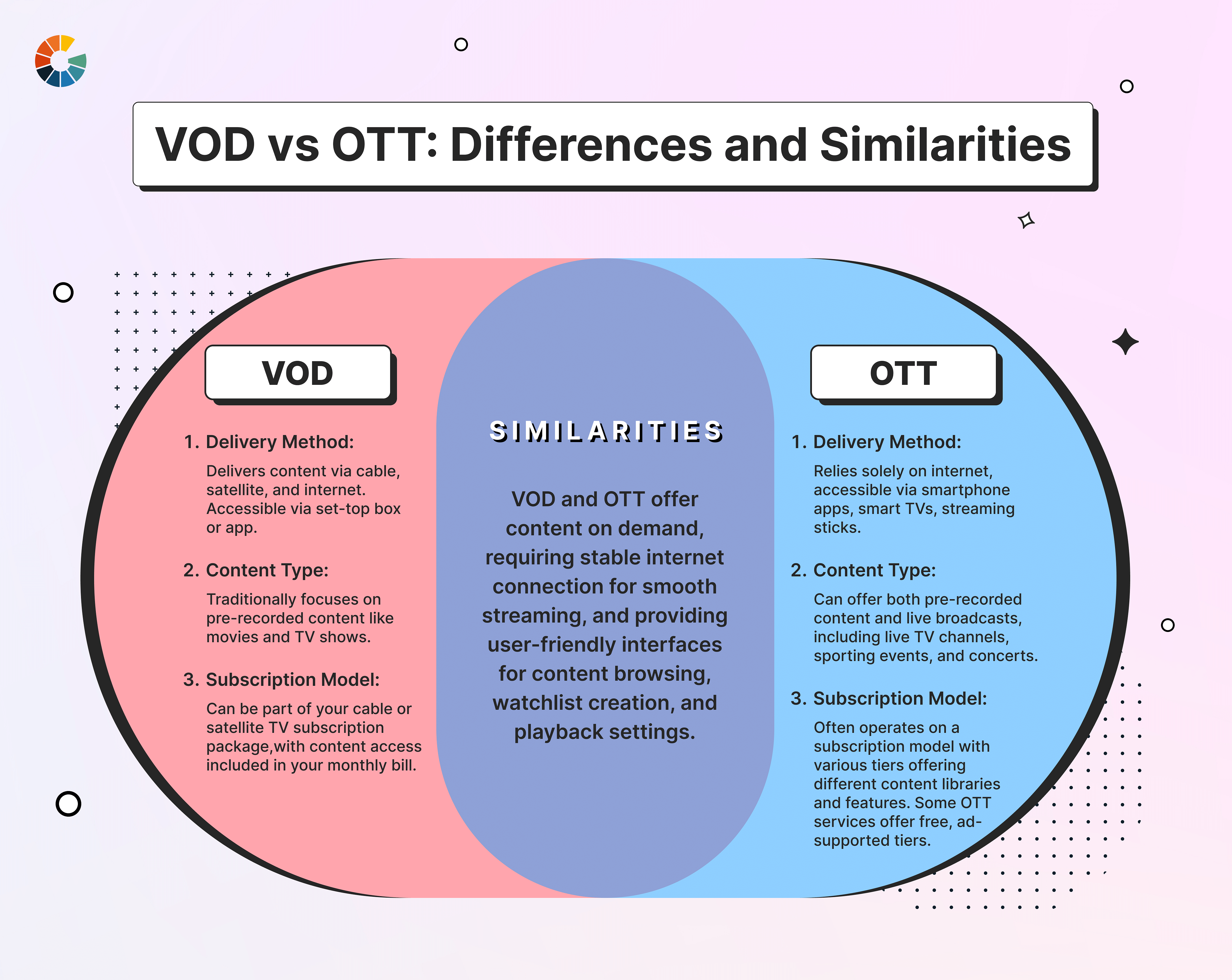
What is the Difference Between VOD and Live Streaming?
| Aspect | Video on Demand (VOD) | Live Streaming |
|---|---|---|
| Content Availability | Pre-recorded content is available for playback on-demand. | Content is broadcasted and viewed in real-time as it happens. |
| Timing | Users can access content at their convenience, anytime. | Content is viewed as it is being broadcasted, in real-time. |
| Interaction | Limited or no interaction with content creators during playback. | Potential for real-time interaction, such as live chat or polls. |
| Flexibility | Flexible viewing schedule; users can pause, rewind, or fast forward. | Viewing is constrained to the broadcast schedule; limited control over playback. |
| Content Diversity | Vast library of pre-recorded content, including movies, TV shows, etc. | Primarily focused on live events, concerts, sports, news, etc. |
| Monetization Opportunities | Subscription-based models, pay-per-view, or ad-supported. | Advertisements, sponsorships, pay-per-view, and subscription models. |
What are the benefits of using VOD streaming platforms?
There is a range of benefits to using VOD streaming:
- For Ed Techs: VOD streaming allows Ed Techs to scale their operations efficiently, reaching a large number of students without the need for physical infrastructure. Additionally, the cost of delivering educational content via VOD platforms is often lower compared to traditional classroom-based methods, making it a cost-effective solution for Ed Techs.
- For News and Media: Live streaming capabilities on VOD platforms enable news organizations to report breaking news and events as they unfold, providing audiences with up-to-the-minute updates and analysis. This real-time reporting enhances the credibility and relevance of news content, attracting viewers seeking the latest information.
- For Content Creators: VOD streaming platforms offer various monetization options, including advertising, sponsorships, pay-per-view, and subscription models. This allows content creators to generate revenue from their content while providing value to their audience.
- For OTT: VOD streaming allows OTT providers to attract subscribers with flexible viewing options, personalized recommendations, and innovative content delivery methods, leading to increased revenue opportunities and market competitiveness.
Types of VOD Streaming Monetization Models
VOD monetization models allow content broadcasters to earn revenue from the videos they distribute on a streaming platform. This could either be through purchase, rental, subscription fee, or ads.
There are five models of content monetization for VOD businesses — SVOD, TVOD, AVOD, NVOD, and PVOD. Let's take a close look:
| Model | Description | Payment | Advantages | Disadvantages | Examples |
|---|---|---|---|---|---|
| AVOD (Advertising VOD) | Free but with ads before, during, and after content. | None (funded by ads) | Free for viewers | Lower revenue per user compared to other models | YouTube, Pluto TV |
| SVOD (Subscription VOD) | Monthly or yearly fee for unlimited library access | Subscription fee | Predictable revenue stream | Competitive market with many options | Netflix, Hulu, Disney+ |
| TVOD (Transactional VOD) | One-time fee to rent or purchase individual pieces of content | Per-item fee | Revenue certainty for each piece of content sold | Lower potential audience compared to subscription model | iTunes, Amazon Prime Video (rentals), Google Play Movies |
| PVOD (Premium VOD) | Recently released or highly anticipated movies at a higher price point. | Per-item fee | Generate additional revenue from existing subscribers | Higher price point may deter some viewers | Apple TV+ |
| NVOD (Near VOD) | Content available for purchase or rental shortly after broadcast. | Per-item fee | Leverages existing content and infrastructure | Limited selection of content | Often offered by cable or satellite providers |
Top 5 VOD Streaming Platforms in 2024
Here's looking at 5 VOD services that are worth checking out:
Gumlet
Gumlet is a top-of-the-line, business-focused video optimization platform that supports professional-grade VOD and Live streaming.
Features:
- Cloud-based video hosting and streaming platform.
- Integrates with various CMS and e-commerce platforms.
- Offers advanced features like adaptive bitrate streaming, DRM, and video analytics.
Benefits:
- Scalable and reliable platform suitable for businesses of all sizes.
- Easy to use with a user-friendly interface.
- Customizable video player and monetization options.
Brightcove
Brightcove is one of the oldest, most powerful VOD platform providers that supports on-demand and live video.
Features:
- Offers video hosting, streaming, management, and marketing tools.
- Provides advanced security features and analytics for large-scale deployments.
Benefits:
- Highly customizable and scalable solution for managing complex video workflows.
- Ideal for businesses with specific security and compliance requirements.
Vimeo
Vimeo is an excellent VOD and CMS tool that allows content creators to host, market, and monetize on-demand content.
Features:
- Popular platform known for its high-quality video hosting and sharing.
- Provides basic analytics and monetization options through Vimeo On Demand.
Benefits:
- Excellent platform for showcasing high-quality creative work and portfolios.
- Strong community for sharing and connecting with other creators.
Dacast
Dacast is a robust VOD solution that allows you to securely deliver on-demand content to people worldwide.
Features:
- Dacast’s S3 FTP upload feature ensures content creators can efficiently share multiple videos at once.
- Dacast’s APIs help you brand your content using your personal CMS—which also helps keep your media library organized and quickly accessible.
- It supports cloud transcoding, HTTPS delivery, and multiple monetization models such as TVOD, AVOD, and SVOD.
Benefits:
- Easy to set up and use, suitable for beginners.
- Cost-effective solution with different pricing tiers based on features needed.
Wistia
Wistia offers the perfect opportunity to build your own powerful, brand-focused VOD platform and host your content to your target audience.
Features:
- Video marketing platform focused on lead generation and engagement.
- Offers interactive video features like calls to action, lead capture forms, and heatmaps.
Benefits:
- Ideal for businesses interested in using video for marketing and sales purposes.
- Helps capture leads and generate conversions through interactive video features.
Conclusion
Businesses can build a robust and profitable video-on-demand platform and serve top-grade content to the growing VOD user base around the world. It will give you complete ownership over your content, allow you to provide tailored user experiences, and maximize revenue.
The key to success? Choosing the best-suited VOD platform for your needs.
FAQs
- Is VOD streaming free?
Depending on the monetization model used, VOD services can be offered for free. For instance, the AVOD model, advertising-based on-demand video, provides comprehensive access to content for free. However, AVOD also includes targeted advertising—which forms the revenue source of the content broadcaster.
- What is pay-per-view (PPV)?
Pay-per-view (PPV) is a system where viewers pay a specific fee to watch a single event, typically live or pre-recorded, that wouldn't be available through regular TV subscriptions or streaming services.
3. How to convert the live stream to VOD?
The easiest way to convert a live stream into a VOD is to record the live stream while it is happening. This can be done with various software or hardware solutions, depending on your streaming platform. The streaming platform will then encode and distribute the video for VOD playback. You can also use a media transcoding service to convert the live stream into a VOD format.
4. What is an example of a video on demand?
Netflix is an example of video on demand. Netflix allows users to access a wide selection of movies and TV shows on demand to watch them anytime. Other examples include Amazon Prime Video, Hulu, YouTube, etc.

